There are so many benefits to a consistent yoga practice, but is weight loss one of them?
Rather than giving you a definite yes, I’m going to be honest with you and say that it depends on you as a person, as well as your actions.
Your overall health, your approach, and the consistency of practice are important to consider when it comes to weight loss.
Truthfully, most people can lose weight on a yogic lifestyle, as long as they take the approach right for them.
However, to make this article easy to follow and relatable for many yogis, I will provide information on how a generally healthy person can lose weight with the help of a balanced, yoga practice and healthy lifestyle.
If you have any injuries or illnesses, please consult your doctor about these styles of yoga before starting, and see if they are right for you. If you are not cleared for yoga, you may find use in contacting a yoga therapist or ayurvedic doctor.
Why Does Yoga Help You Lose Weight?
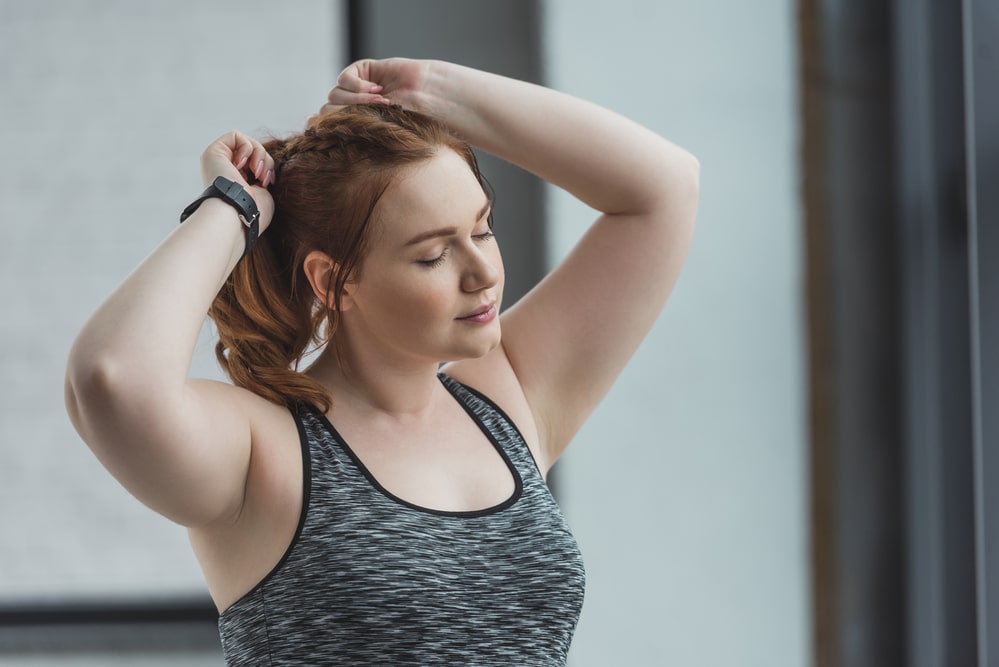 Yoga can help you lose weight directly and indirectly.
Yoga can help you lose weight directly and indirectly.
Indirectly, practicing yoga will likely guide you to other healthy habits, such as adapting to a whole-food, plant-based diet, managing your anger and stress, which positively affects your metabolism, and turning to healthy coping mechanisms that don’t involve drinking alcohol or emotional eating.
You may also spend time and make friends with other yogis that are positive influences, making it easier to stay on the path to a healthy lifestyle.
Directly, yoga can help you lose weight by increasing your metabolism through movement, allowing you to lose fat, and gain lean muscle.
Muscle takes more energy to maintain, and therefore, more fat is broken down while maintaining this muscle. Practicing yoga can also help with water retention by causing you to sweat through consistent movement and the tension of muscles when you hold poses.
Not all yoga is created the same though.
Relaxing yoga can indirectly help you lose weight by giving you a sense of tranquility, relieving pain, and clearing your mind to make positive choices and motivating you to choose healthy food habits.
Yoga styles that will directly help you to lose weight are more active and will challenge your cardiovascular system and build muscle. We’ll discuss these active and relaxing yoga styles next.
The Best Yoga Practices for Weight Loss
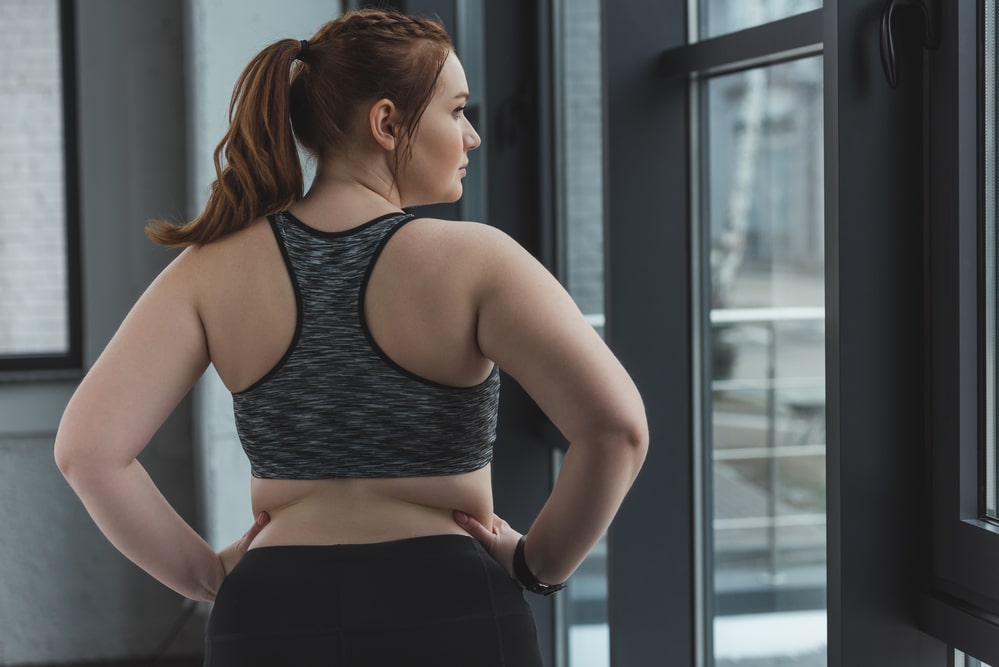 By combining yoga styles that focus on your physique, as well as your mental health in your daily yoga practice, you’ll be best prepared to lose weight in a healthy, safe way.
By combining yoga styles that focus on your physique, as well as your mental health in your daily yoga practice, you’ll be best prepared to lose weight in a healthy, safe way.
Below, I’ll explain some of the relaxing yoga styles that will indirectly help you to lose weight, as well as the active yoga styles that will directly help you to lose weight.
This will include a description of each yoga style, how it helps you with weight loss and the frequency you should be practicing to see results.
Whichever you decide to do, be sure to include at least one relaxing technique and one active technique in your practice.
Yoga Styles That Indirectly Help with Weight Loss
Since meditation is an aspect of yoga, I believe it’s important to mention it as an indirect action to lose weight. Meditating is not always sitting crossed-legged and focusing purely on your breath.
It’s possible to add a theme and positive affirmations to your meditation practice and these positive affirmations can be related to losing weight.
For example, you can think or say, “I turn to my breath when I feel stressed” or “I fuel my body with nourishing foods.”
If you struggle with emotional eating or eating processed food, use meditation as a time to rewire your mindset and everyday choices.
It’s most effective when you add it to your daily routine, even if some days you can only squeeze it into 5 or 10 minutes of the day.
However, if you have more time to meditate, do try to practice for at least 20 minutes. Adding some music in the background, sitting outdoors and hearing nature, can often make it an even more pleasant experience.
If you are new to meditation, you may find seeking guided meditation classes in your area to be helpful for staying focused and making your practice more effective.
Yin Yoga Sequence for Weight Loss
If you need more movement when you’re trying to relax and nourish your body, Yin yoga might be for you.
During Yin, you hold each pose for 3 to 5 minutes. This allows your body to relax into the pose, and stretch more profound, or deep muscles that you wouldn’t target practicing a faster yoga style.
Staying in these poses also teaches you the benefits of slowing down in everyday life, lowers your heart rate, and relieves stress.
Try to practice Yin yoga daily. You can do a short Yin practice before an active practice as a warm-up, and you can do longer Yin practices on days you’re feeling emotional to process your emotions in a healthy way.
Yoga Styles that Directly Help with Weight Loss
One of the popular, active yoga styles that directly helps you to lose weight is called Vinyasa Flow yoga.
This style of yoga is a descendant of Ashtanga yoga, with very minimal differences. Poses are the same, but Vinyasa allows the teacher to teach the poses in different orders each class.
Whereas in Ashtanga, there’s a couple of fixed sequences, and students must go to school to learn the sequences in a specific order.
Due to the allowance of more creativity, most Western yoga teachers opt to teach Vinyasa Flow yoga.
Now that I have explained the differences between Vinyasa Flow and Ashtanga, let me go more in depth on Vinyasa Flow. From Sanskrit, Vinyasa translates as “to place in a special way”. This refers to the fact that during Vinyasa Flow yoga, poses are ordered in a specific way to fluidly move, or flow, from one to the next.
Due to this consistent movement, you receive a good cardio workout from this class which is very helpful for burning fat. The teacher may also have you hold some challenging poses for a couple of breaths, causing your body to build muscle, which also is effective for fat loss.
However, you may find that Vinyasa Flow classes may differ in pace. For the most optimal weight loss effectiveness, choose classes that are fast enough to raise your heart rate, but slow enough that you can breathe through the poses.
Some modern teachers go way too fast, making many yoga practitioners dizzy from not being able to regulate the breath. Other Vinyasa Flow classes may be called “Slow Flow”, which isn’t the most useful for weight loss, but it’s great for Vinyasa beginners to get an idea of how to practice.
Once you begin a Vinyasa class, be sure to practice this style for an hour at least 3 days a week, with other forms of lighter exercise such as Yin yoga or walking to see gradual, weight loss results.
Bikram Yoga Workout
If you’re not into fast movement, but enjoy the idea of muscle toning and getting a good sweat, Bikram yoga or hot yoga may be a better fit for you.
Just as I explained with Ashtanga and Vinyasa Flow, Bikram yoga and hot yoga are very similar aside from the fact that Bikram yoga has a fixed yoga pose sequence for each class, while hot yoga gives the teacher more freedom to be creative with the sequences.
Also, while Bikram Choudhury created a popular style of yoga, he’s gotten in a lot of trouble in the past few years, so some studios like the concept of his yoga style while not wanting to be associated with his name.
So what’s the basis of Bikram yoga and hot yoga?
In these classes, yoga is practiced in a heated room ranging from 92° F to 105° F. The specific poses done in these classes are a combination of muscle and flexibility building.
Not all poses are beginner-friendly, so it’s best to practice a different style of active yoga before trying Bikram or hot yoga.
With that being said, these classes are some of the best for burning many calories, building strength and achieving a toned, slim body, so it’s certainly worth trying when you’re ready!
Bikram has recommended practicing daily, but many yoga teachers say that three to four times a week is better to let your body heal between sessions, as well as prevent dehydration.
All in all, the best frequency is different for everyone, so listen to your body. However, I’d recommend at least three times a week to see results.
Yoga Asanas for Weight Loss
We truly believe that yoga can be a great exercise for weight loss by building muscles and improving flexibility. Yoga is known as a fat burning exercise you can do without breaking a sweat.
Not only does yoga burn calories, but it also improves your mental state as well.
People tend to have a poor diet when they are stressed and yoga aids in stress reduction, which results in you making better decisions regarding your nutritional choices.
Cortisol is the hormone related to stress, and having more cortisol can make it difficult to lose weight, but yoga naturally reduces cortisol levels, making it easier to lose weight.
As with anything, you get out of yoga what you put into it.
It’s easy to go through the poses of yoga without much thought or effort, but to get the most out of this type of exercise you will need to challenge your mind as well as body.
To get the most out of yoga, you must push yourself beyond your comfort zone.
What is Asana?
The term asana essentially means “yoga pose.”
Asana is a Sanskrit term and literally means “to be in a comfortable seated position.”
The word refers to the mental relaxation and physical exertion that results from a subgroup of yoga called Ashtanga. As you continue to practice asanas or yoga poses regularly you will gain mental and physical awareness.
Along with the commonly known name, the Sanskrit name will be listed.
Some asanas require repetition on the opposite side as they only work muscles on one side. If a pose needs to be performed on both sides it will be stated within the instructions.
It’s essential that if a pose requires repetition on the other side that you take the time to do so. This will help you can evenly build muscle and flexibility in your body.
13 Yoga Asanas for Weight Loss
 1. Wide-Legged Forward Bend Pose – Prasarita Padottanasana
1. Wide-Legged Forward Bend Pose – Prasarita Padottanasana
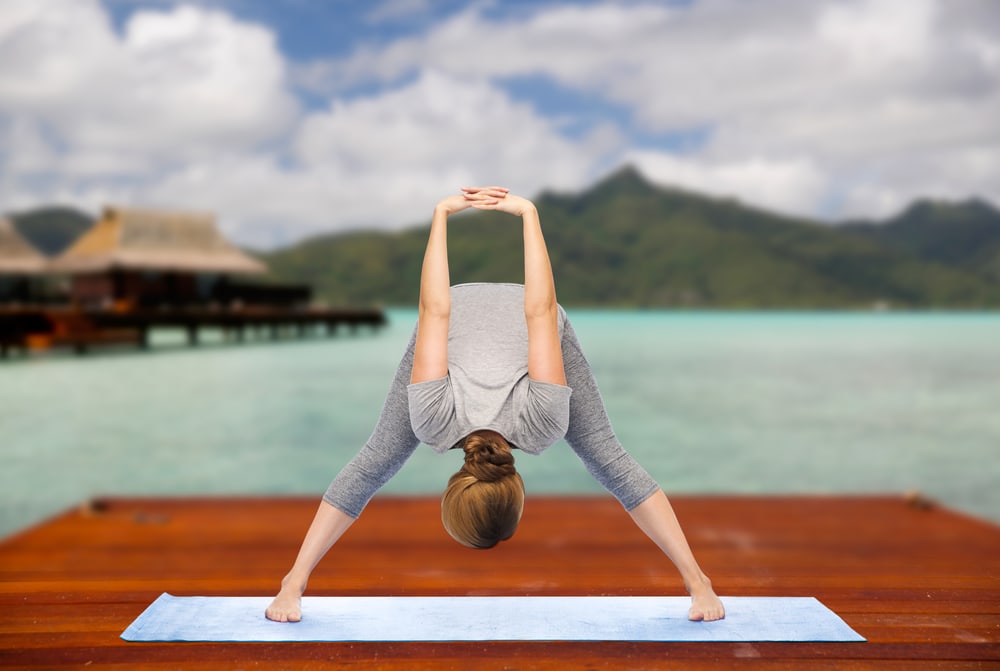 Start by standing tall on the ground, either on the floor or yoga mat. Move your feet so that they are about 4 feet apart and in line.
Start by standing tall on the ground, either on the floor or yoga mat. Move your feet so that they are about 4 feet apart and in line.
Think of your hips as a hinge as you lean your upper body towards the floor. Typically you would extend your hand to touch the floor, but for an extra shoulder stretch reach your arms behind you and clasp your hands together.
While maintaining this pose, ensure that your back stays straight and not arched. When done properly, this pose will stretch your hamstrings.
Hold this pose for 30 seconds.
2. Lunge Pose – Anjaneyasana
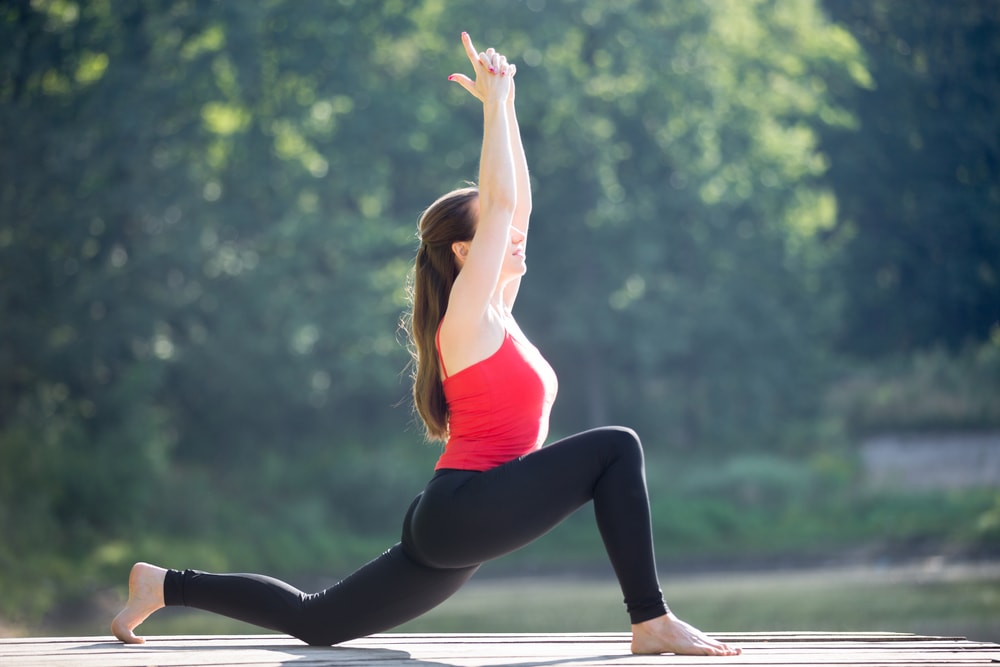 This pose is great for tight hips, which most people who work desk jobs have, as it stretches the hip flexors. If a goal of yours is to have the ability to do a split, then this is also a great asana to improve flexibility for that pose.
This pose is great for tight hips, which most people who work desk jobs have, as it stretches the hip flexors. If a goal of yours is to have the ability to do a split, then this is also a great asana to improve flexibility for that pose.
Hand placement is determined on which muscle you wish to stretch. Along with your hips, your back will be stretched if you extend your hands up and reach back.
Your lower back will be stretched if your arms remain to your side during the pose. If you feel discomfort during this pose, your hands can also sit on your knees, but this will reduce the amount of stretch your hips receive.
Try to keep your bent knee at a 90-degree angle.
This is a pose that will need to be repeated on both sides, aim for 30 seconds on each side.
3. Half Boat Pose – Ardha Navasana
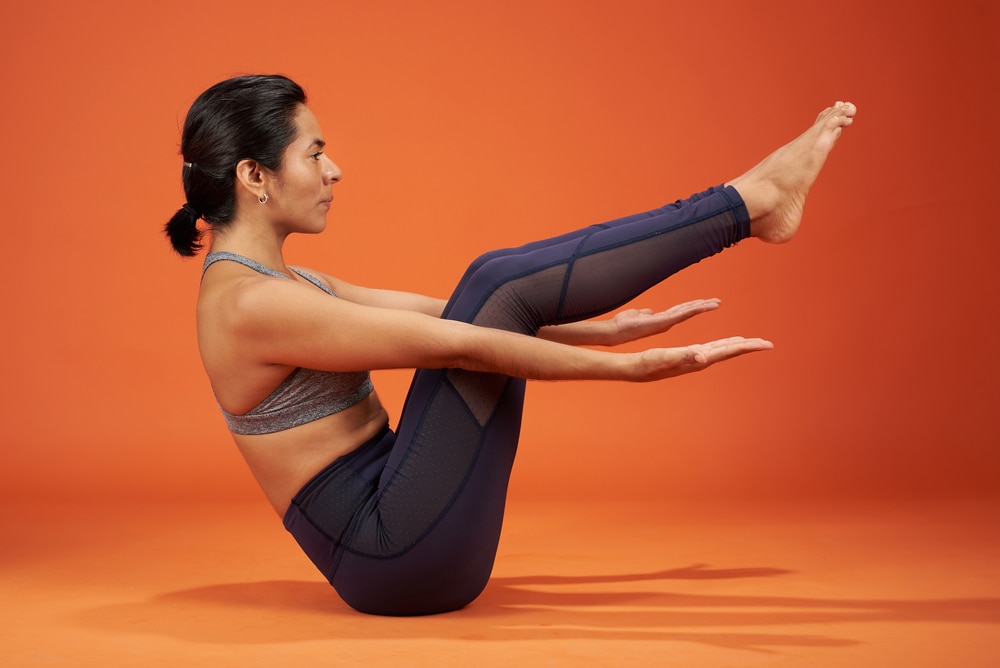 You will feel this pose working your abdominal muscles. Start by sitting on the floor or yoga mat, and place your hands next to your hips on the ground.
You will feel this pose working your abdominal muscles. Start by sitting on the floor or yoga mat, and place your hands next to your hips on the ground.
Lift your legs and when you feel balanced, lift your arms so that they are extending forward and are right below your legs.
To make this pose harder, you can lower your back and legs. For another version, to add difficulty, try straightening your legs completely.
This pose should be held for 30 seconds.
4. Side Plank Pose – Vasisthasana
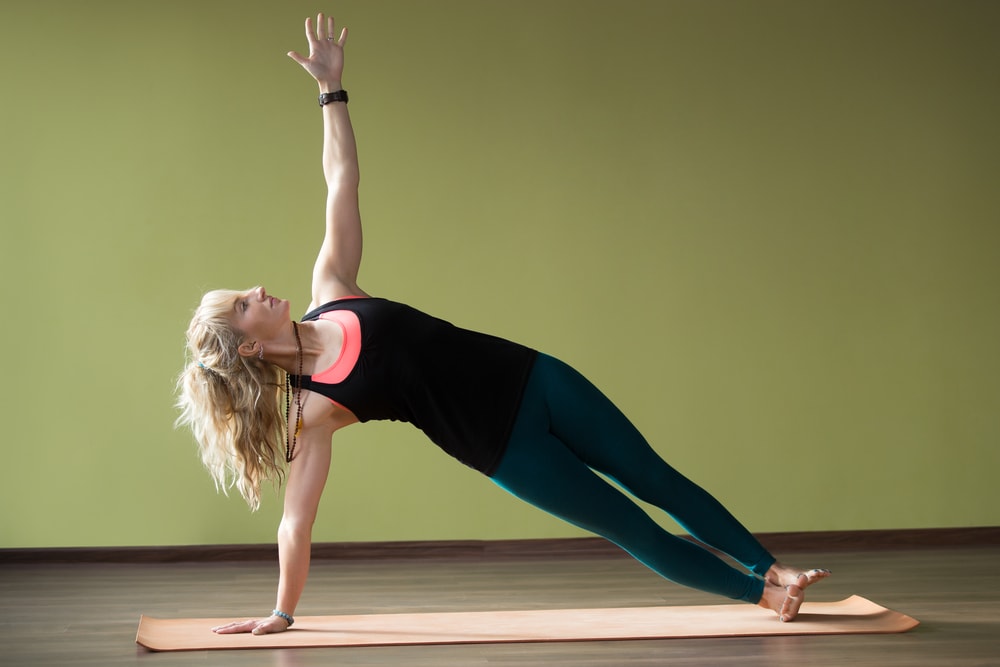 There are many types of plank poses, and they all work the ab muscles, which in turn makes them great for weight loss.
There are many types of plank poses, and they all work the ab muscles, which in turn makes them great for weight loss.
To get into this pose, start in a typical plank pose with hands pressed against the ground and fingers spread out. Your arms should be planted shoulder-width apart and your legs should be glued together.
Rotate both your feet to the left stacking your right foot on the left, with the side of your left foot planted on the ground.
Rotate your weight to your right hand, extending your left hand towards the sky.
This pose should be repeated on both sides, for 30 seconds a side.
5. Tree Pose – Vriksasana
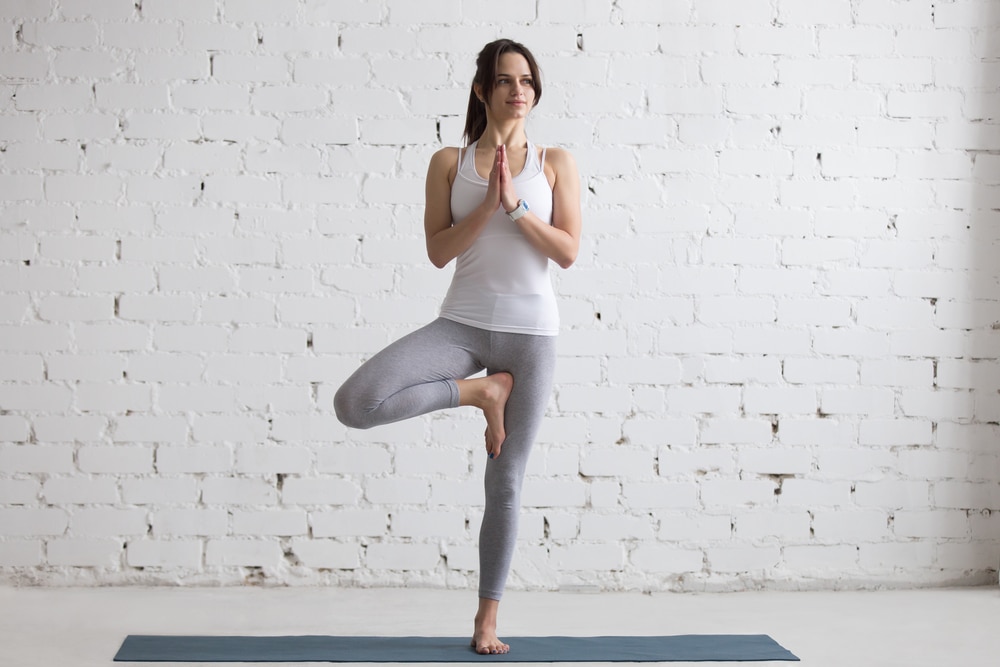 This asana requires a great deal of balance!
This asana requires a great deal of balance!
Start by standing tall on the ground, and slowly raise and bend your left foot, so that it becomes pressed against your right thigh. Stand straight throughout this pose, as your body may want to arch.
Hold your hands in front of your chest, palms touching. If you feel comfortable, you may lift your hands up, above your head.
This pose will need to be repeated on both sides for 30 seconds on each side.
6. Revolved Lunge Pose – Parivrtta Anjaneyasana
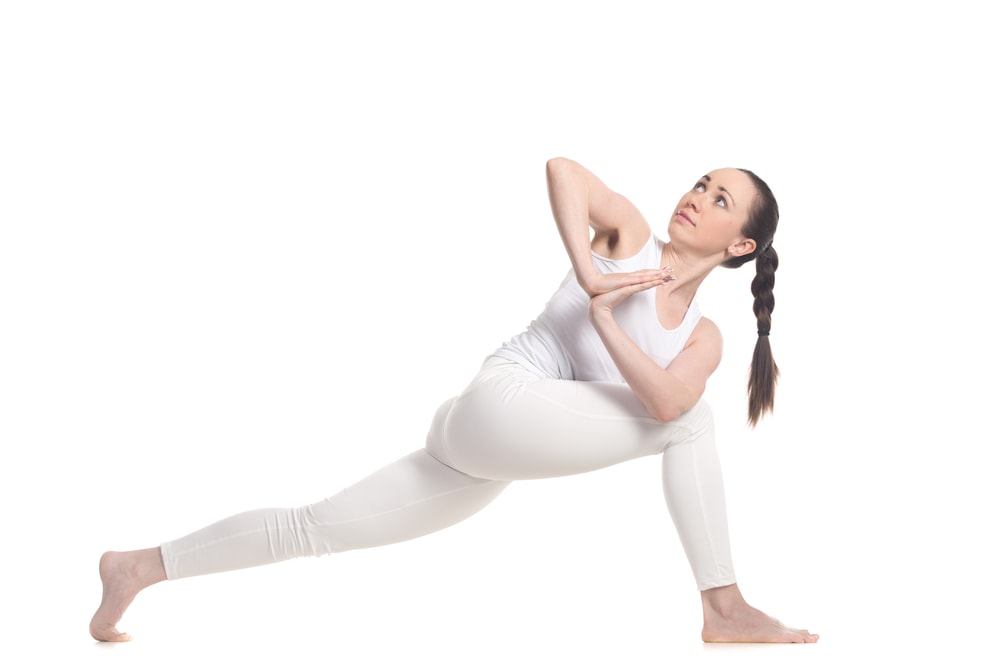 Begin this pose in a lunge position, with your right foot up front and knee bent at 90 degrees. Rotate your upper body to the right and keep your legs planted on the ground.
Begin this pose in a lunge position, with your right foot up front and knee bent at 90 degrees. Rotate your upper body to the right and keep your legs planted on the ground.
You may place your hands on the ground to help with balance as you get into this pose.
Try to extend the rotation so that your left elbow sits on the outside of your right knee. You can hold your hands together in front of your chest for a deeper stretch in your shoulders and back.
To add another muscle strengthening component to this pose, focus on engaging your core muscles.
This pose will need to be repeated for both sides and should be held for 30 seconds on each side.
7. Chair Pose – Utkatasana
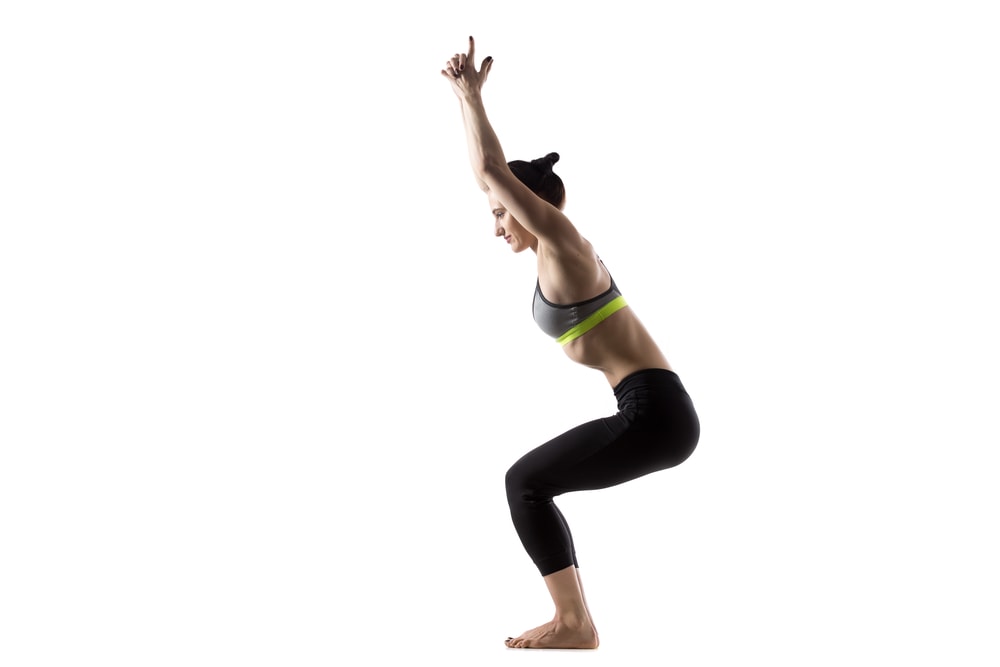 This pose has similarities to a squat hold and works the same muscles, but it’s the “yoga” variation. This will work your quadriceps.
This pose has similarities to a squat hold and works the same muscles, but it’s the “yoga” variation. This will work your quadriceps.
Start with your feet together, planted on the ground, and sit back into a slightly squatted position. To ensure your knees aren’t overextended, check to make sure that you can always see your feet.
Keep your back as straight as you can, and go as low as you can while maintaining proper form.
Try to hold this asana for 30 seconds.
8. Warrior I – Virabhadrasana I
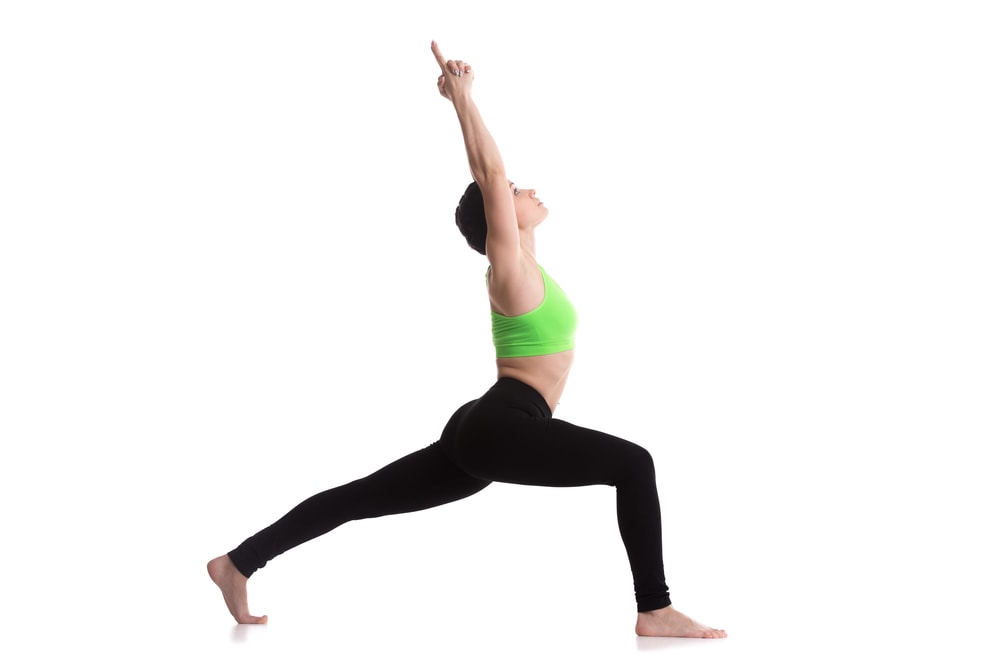 This pose is known to be good for weight loss due to its strength and balance components and is often performed as part of a sequence with Warrior II.
This pose is known to be good for weight loss due to its strength and balance components and is often performed as part of a sequence with Warrior II.
To begin, stand tall with your feet firmly planted on the ground. Move your right foot apart from your left, so that there is about a four feet gap between your feet. Pivot your left foot inward so that it is at roughly a 45-degree angle. Move your body so that you are facing the right side.
To further the stretch, begin sinking into your right knee, but make sure your left leg remains straight. You want to keep your right knee at a 90-degree angle and keep your right thigh parallel to the ground.
You will feel this pose in your spine, chest, and hips.
Repeat to complete for both sides of your body and hold for 30 seconds, and then transition into the Warrior II pose.
9. Warrior II – Virabhadrasana II
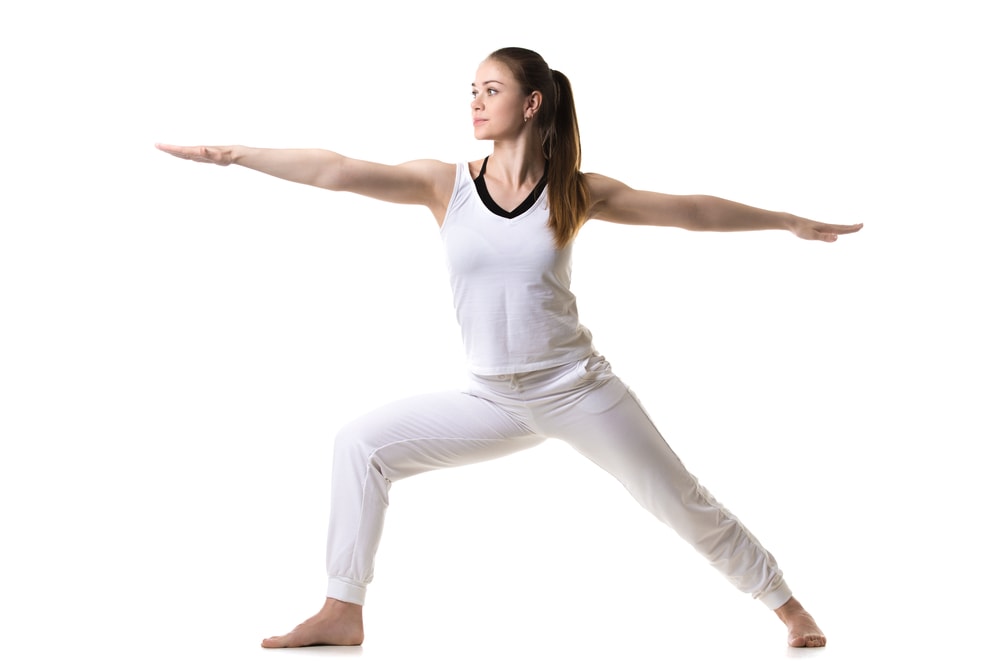 To get into this pose from Warrior I, reach both arms out to your sides so that they are parallel to the ground. Rotate your upper body to face forward, keeping your knee at a 90-degree angle.
To get into this pose from Warrior I, reach both arms out to your sides so that they are parallel to the ground. Rotate your upper body to face forward, keeping your knee at a 90-degree angle.
This pose will be repeated on both sides for 30 seconds each. Upon completing this pose you will move into Warrior III.
10. Warrior III – Virabhadrasana III
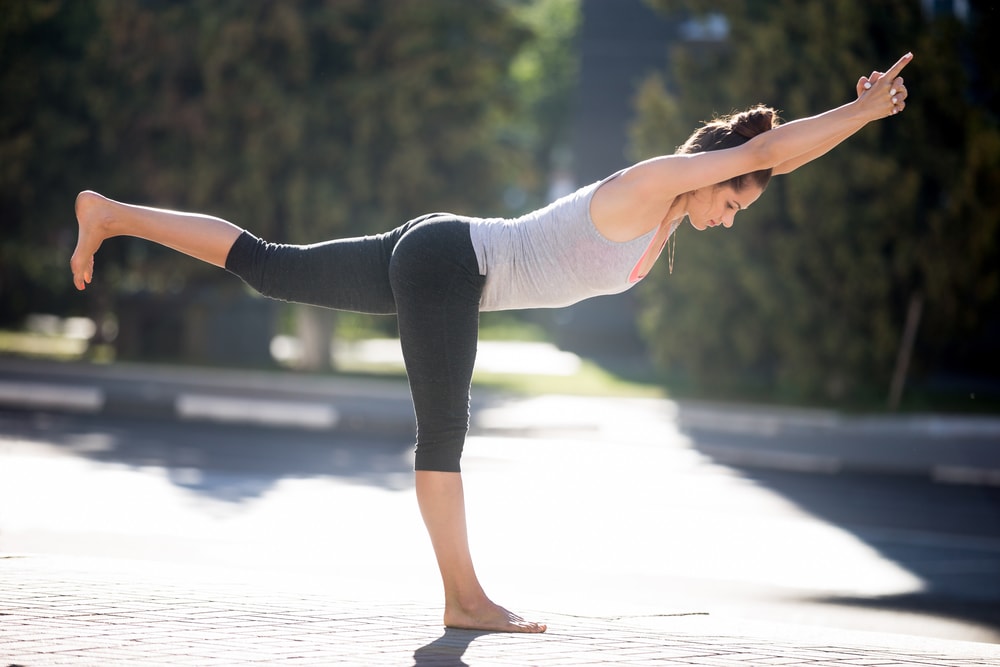 This variation of a warrior pose is the most challenging. It requires a lot of balance to hold longer than a couple seconds.
This variation of a warrior pose is the most challenging. It requires a lot of balance to hold longer than a couple seconds.
To transition from Warrior II, have your upper body face forward reach both arms out forward. Reaching your arms out first will aid in balancing.
You may not have the stamina to lift your leg as far as the picture depicts if you are new to yoga, but you may lift it as high as you can and over time you will improve.
Repeat this pose on each side, for 30 seconds on each side.
11. Shoulderstand Pose – Sarvangasana
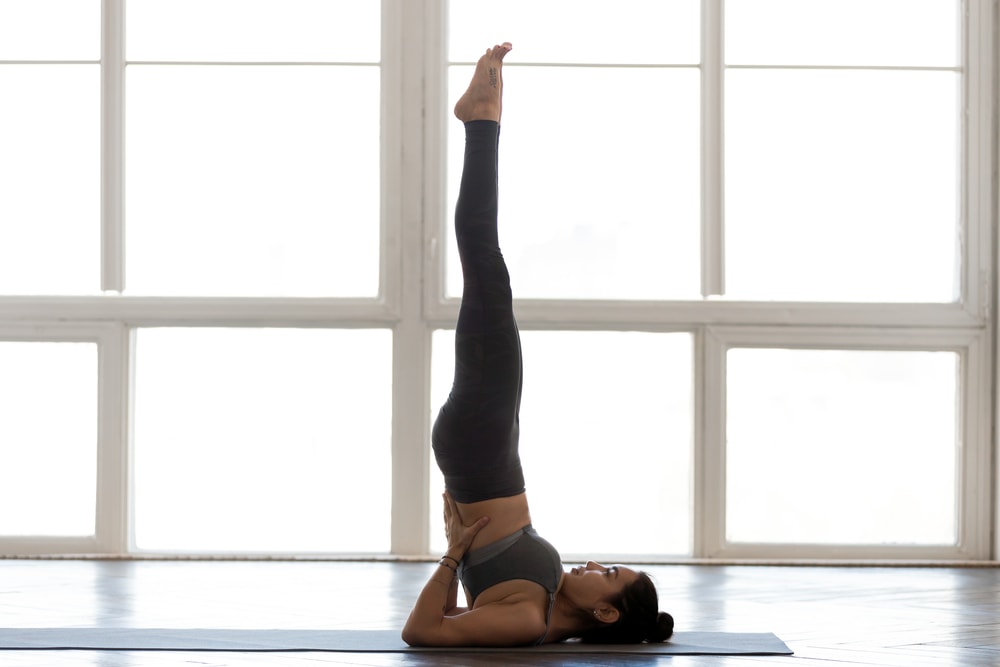 Inversions are types of yoga poses where your body is up-side-down, such as a headstand. This asana is an inversion.
Inversions are types of yoga poses where your body is up-side-down, such as a headstand. This asana is an inversion.
To start this pose, you will lie on the ground. Lift your legs into the air, but keep your knees bent at first. Using your hands, position your body so that the upper back and neck are in contact with the ground, and the rest of your body is suspended.
Use your upper arms to support you during this pose, as your hands press against your lower back.
With your hands against your back, reach your legs towards the ceiling. If this pose is challenging, you add stability by moving your hands up so they are pressed against your hips.
This pose should be held for 30 seconds.
12. Lord of the Dance Pose – Natarajasana
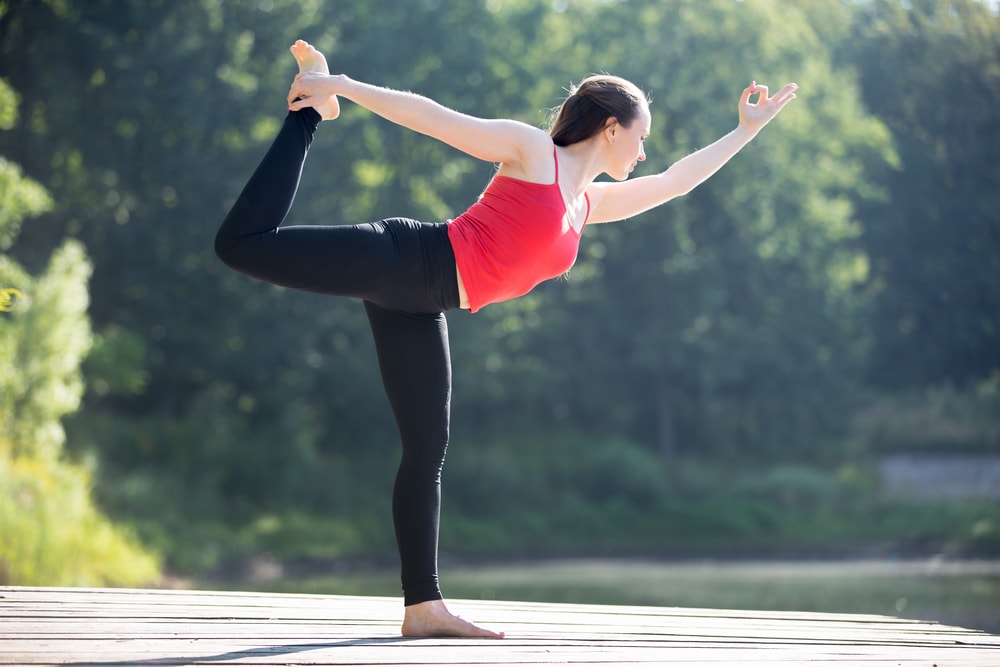 This pose of great for beginners, as it is easier and gives your body a good stretch.
This pose of great for beginners, as it is easier and gives your body a good stretch.
Begin by standing tall on the ground with your feet shoulder-width apart. Lift back your left lack and grasp your left ankle with your left hand. Begin balancing on your right left. If you need additional support for balance, you may rest your right hand on your right knee.
Arch your back and ground yourself with your right foot, ensuring your right leg remains straight.
Repeat this pose on both sides, 30 seconds on each side.
13. Crow Pose – Bakasana
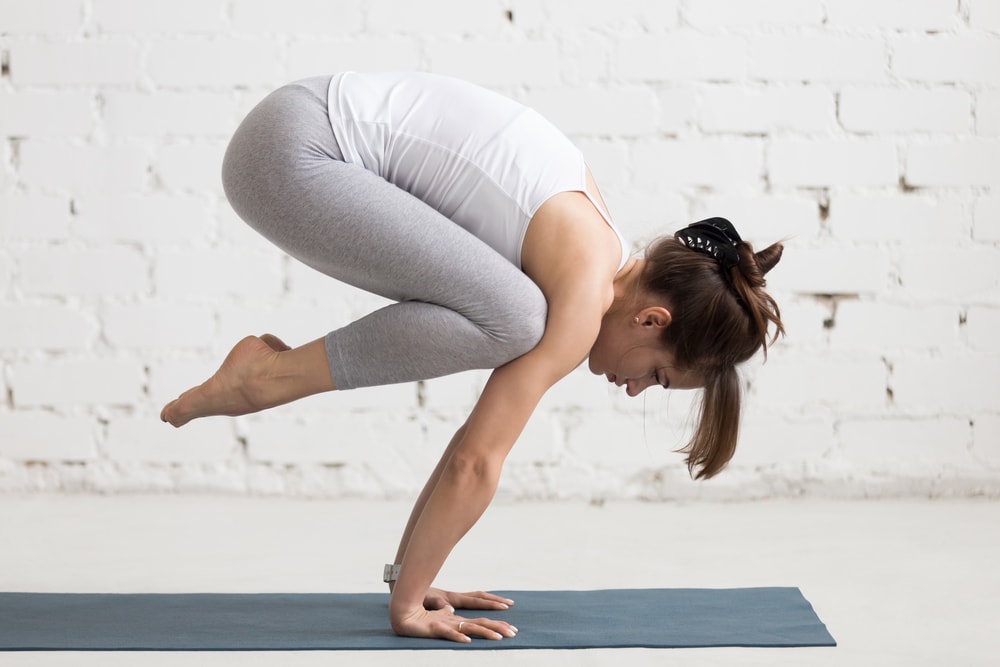 This asana will take time to fully master, as it does have a higher difficulty, but it strengthens your arms muscles in the process!
This asana will take time to fully master, as it does have a higher difficulty, but it strengthens your arms muscles in the process!
To start this pose, get into a low squat position. Press your hands onto the ground in front of you and spread your fingers wide. Ensure that your knees are spread wider than your shoulders.
Begin putting more of your body weight on your hands allowing your feet to rise, resting on your tiptoes. Throughout this pose, keep your back rounded and your ab muscles tightened. Try to lift one leg initially, and as you build strength aim to elevate both legs.
Cool Down
This workout provided poses for a vinyasa sequence that will aid in weight loss. There is one more pose that will be included, as a cool down or resting pose upon the completion of the poses listed above.
As you begin to practice yoga, you may find that your muscles tire quickly. Whenever this occurs, you can come into child’s pose.
Child’s Pose
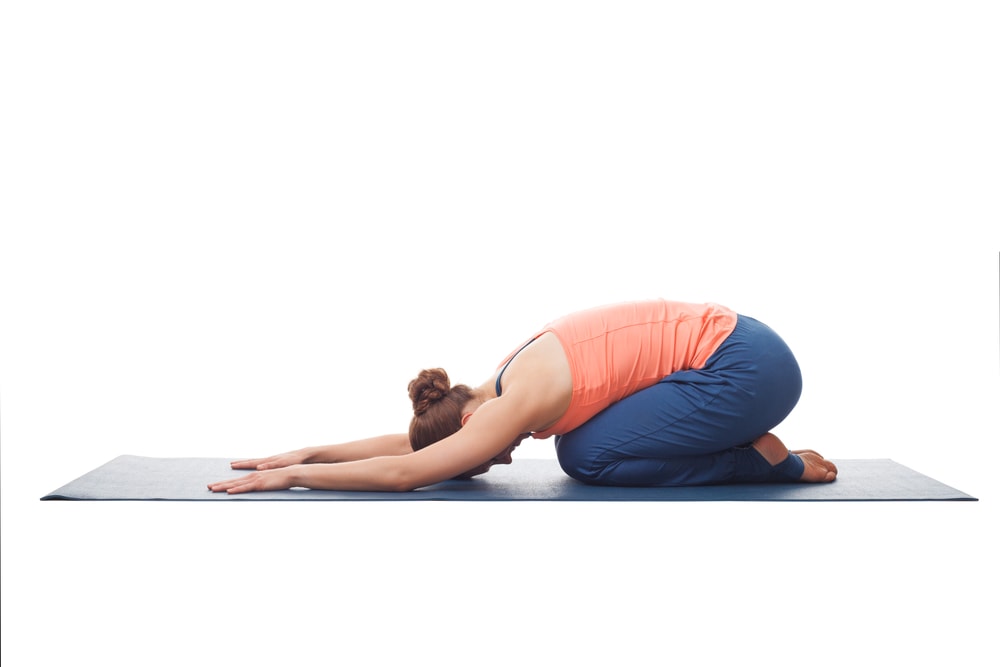 To get into this pose, begin by kneeling. With your toes sticking together, spread your knees apart. Bend your upper body forward allowing your face to rest on the ground.
To get into this pose, begin by kneeling. With your toes sticking together, spread your knees apart. Bend your upper body forward allowing your face to rest on the ground.
Your arms can either rest behind you or reach out in front of you. While holding this pose, you should not feel any stretch. Hold this pose for your desired length.
Learning How to Lose Weight with Yoga (Everyone’s Weight Loss Journey Differs)
A weight loss journey through yoga will be a different experience and personal for everyone. Even for generally, healthy people, our metabolisms are different, self-discipline differs, and diet does too.
One person may see weight loss within a couple weeks, while another person sees weight loss after a couple months. Neither is better or worse.
Also, practicing yoga poses is only one aspect of weight loss, so if that is the only change you make in your life, you may not see the quickest of results or any for that matter.
One must also be sure to eat a healthy diet, burn more calories than they consume, and stay consistent with their yoga practice and other exercise regimens.
If you are only following a healthy lifestyle once a week, you’re not going to see a difference in your life aside from short-term happiness during those days.
Balance a Yogic Lifestyle with Mild Indulgence
Most yogis fall off the path at some point or another, so don’t beat yourself up if you’ve been consistent for a while and then skipped a day or a week of yoga.
Many people may quit or punish themselves with overeating, a night out at the bar, or by using drugs, but this is not a helpful approach, and will, in fact, hinder your progress.
Instead, recognize that you have gone off the path for a while, and without judgment, come back to it.
Remember the aspects of yoga that make you feel good. Practicing yoga and being healthy is rewarding. It is not meant to stress you out or feel like a chore.
The balance of healthy living and mild indulgence (i.e., eating a chocolate dessert, having two beers, or watching YouTube videos) is helpful for staying consistent.
If you are known, for example, to watch a lot of TV or play video games for hours, substitute some of those hours for yoga and preparing a healthy, plant-based meal. You can still save an hour or two to watch your favorite TV show or play a video game with your friends.
This way, you will see gradual weight loss results and improved health without feeling deprived or punished for your other hobbies.
This will also help you to stay on the yoga path, enjoy it, and not have a resentful attitude towards a healthy lifestyle.
Why You Can Lose Weight with Yoga
If you have a history of struggling with weight loss and maintenance, yoga is useful to turn to, not only to lose the weight, but also for healing any negative thoughts, or memories that you have encountered in regards to weight-related issues in the past.
Plus, you are not alone in this journey. Many yoga teachers such as myself, are here to help you as well.
If you ever find yourself struggling to lose weight on a yoga lifestyle, do not hesitate to reach out to yoga teachers that specialize in weight loss to answer questions or guide you.
Starting a yoga practice in itself can be daunting, and we know that, so we have the tools to show you the way with empathy, knowledge, and support.
Remember that learning takes time, and as long as you grow your passion and desire to expand your knowledge of yoga, self-love, health, and healing, you will see incredible results that will last for a lifetime.

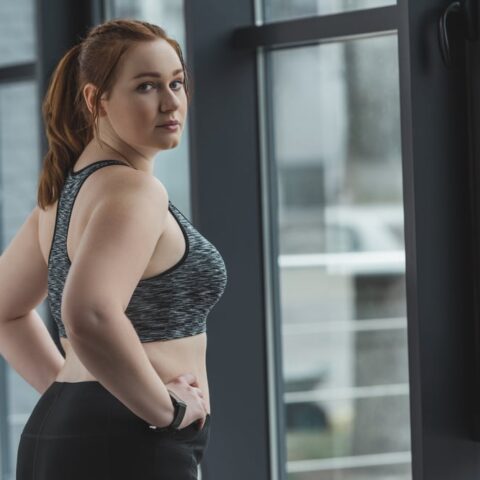
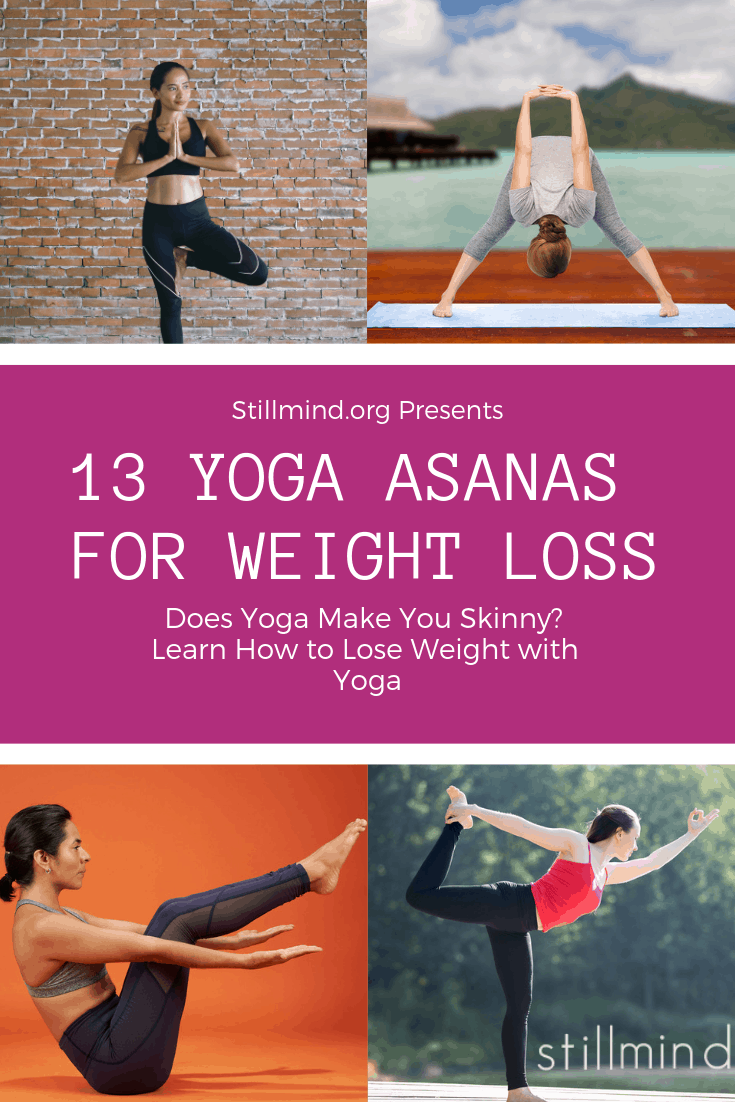 1. Wide-Legged Forward Bend Pose – Prasarita Padottanasana
1. Wide-Legged Forward Bend Pose – Prasarita Padottanasana